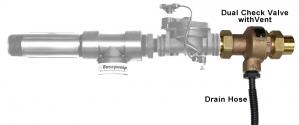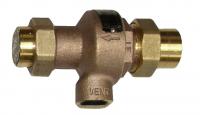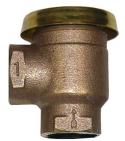Basepump
Backflow prevention for water powered sump pumps


“Ask for it by name”
Backflow Prevention
- Backflow is a term used in the plumbing industry for an unwanted flow of water in the reverse direction. It can be a serious health risk for the contamination of potable water supplies with foul water.
- A water powered sump pump has a point where the clean “city” water and the dirty sump water meet. This is considered a “cross-connection” and during a backflow event, sump water could be pulled backward into the potable water supply.
- The standard Basepump design incorporates a control valve that is in the closed position until activated by a float in the sump.
- At any time that the ejector is not operating, the control valve at the pressurized potable water supply is closed, the suction pipe is empty, and the discharge pipeshould also be empty as a typical installation should have it open to the atmosphere on the exterior.
- During normal operation, the pressurized, potable water is in a forward-flowing, “positive pressure” condition.
- If the potable water supply loses its pressure during pump operation and actually pulls into “reverse” causing a “negative pressure” condition, it is possible for sump water to be siphoned back into the potable water supply pipe.
- Because this can only happen during a pumping cycle, the likelihood of such an occurrence is extremely remote. Each Basepump is designed to minimize this risk, but most authorities require that an “approved” backflow prevention device be added to a Basepump installation to protect the potable drinking water supply.
- So we don’t just talk about it, we make them available. See them here below:
Backflow Prevention Devices for RB750 and HB1000:
Dual Check Valve
- The standard Dual Check Valve is a generally accepted backflow prevention device and we have them available in 3/4″ size. (1/2″ available only until stock runs out.)
- Installation of a standard dual check valve into the potable water supply piping prior to its entry into the pump prevents water from flowing in the opposite direction.
- This brass device contains two internal check valves for redundancy, or a “fail-safe” condition. This allows water to flow through it in only one direction.
Standard Brass Dual Check Valve
- Installer inserts this into the water supply pipe that feeds water to the pump.
- Depending on the water pressure, the use of this check valve may reduce the pumping volume slightly.
- Meets ASSE listed #1024, CSA Certified B64.6
-
Dual Check Valve Model:
- DCV-¾” $41.00
Standard Brass Dual Check Valve
Dual Check Valve with Vent (State of Illinois Approved)
- Dual Check Valve with Vacuum Breaker Vent (3/4″ only).
- Installation of the dual check valve with vacuum breaker vent does the same job as the standard dual check valve, but has the added feature of a vacuum breaker, downstream vent.
- This type of Dual Check Valve also contains two internal check valves that only allow water to flow through it in one direction.
- Downstream vented vacuum breaker gives added protection as required in some jurisdictions.
- Depending on the water pressure, the use of this check valve may reduce the pumping volume slightly.
Dual Check Valve with Vent
- Meets ASSE listed #1012, CSA Certified B64.3
- State of Illinois Approval #890-1140(k)
-
Dual Check Valve with Vacuum Breaker Model:
- DCV-VB-¾” $52.00
Dual Check Valve with Vent
Atmospheric Vacuum Breaker (AVB) Valve (State of Wisconsin Approved)
- Many municipalities recognize an Atmospheric Vacuum Breaker (AVB) as an effective means of preventing back-flow in certain cases.
- In the unlikely event that the potable water supply loses its pressure during a pumping cycle, and actually pulls into “reverse” causing a “negative pressure” situation, the AVB immediately opens to atmosphere, which effectively prevents a siphon.
- Basepump is able to use this device because of its location on the ceiling, giving it the necessary height to prevent water from backing into the potable water supply.
Atmospheric Vacuum
Breaker (AVB) Valve
- Install AVB valve at least 6″ above the next highest point of discharge. The configuration of the pump provides this 6″ rise and the discharge must continue on a level or downward pitch to the exterior so as to self-drain when the pump shuts off.
- Note: If the discharge rises above the pump to the exterior, the AVB valve will spill the remaining water back into the basement after shut-off. It is an open air vent.
- Do not connect the discharge from the Basepump into the discharge from the primary sump pump when using the AVB Valve. It will cause the primary pump to send water back to the Basepump each time it runs and it will spill from the open Vacuum Breaker.
- The 3/4″ unit, as shown above, is an “add-on” to Models RB750 and HB1000. Installer must insert this unit into the ejector according to directions sent with the unit.
- If it is purchased with the pump and then later the installer determines that it won’t fit the application, you may return it for a refund.
- Meets ASSE listed #1001, CSA 64.1.1 Certified, IAPMO Listed.
- State of Wisconsin Approval# 20100389
- State of Minnesota Approval# 603.5.9
- State of Ohio Approval# 608.3
- State of Indiana Approval# 608.3
Atmospheric Vacuum Breaker Model:
- AVB 3/4″ $38.00
FREE Basement Evaluation Checklist
Click the "Free Checklist" button to receive a free Basement Evaluation Checklist to use as a guide to protecting your basement from flood damage. This is a worksheet designed for you, the homeowner, to put the important information regarding your basement onto one sheet and to use it as a guide for risk management.
FREE Basement Evaluation Checklist
Fill the "Form" to receive a free Basement Evaluation Checklist to use as a guide to protecting your basement from flood damage. This is a worksheet designed for you, the homeowner, to put the important information regarding your basement onto one sheet and to use it as a guide for risk management.






